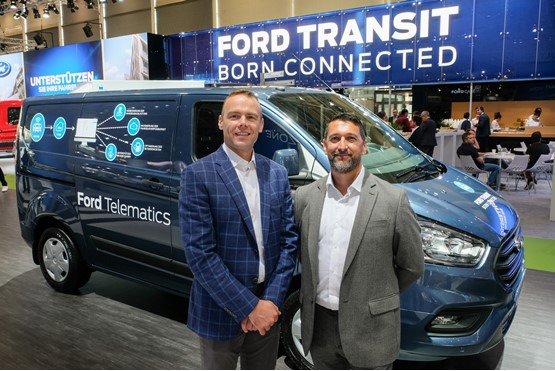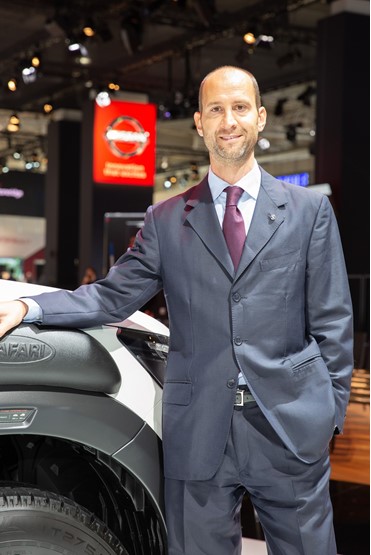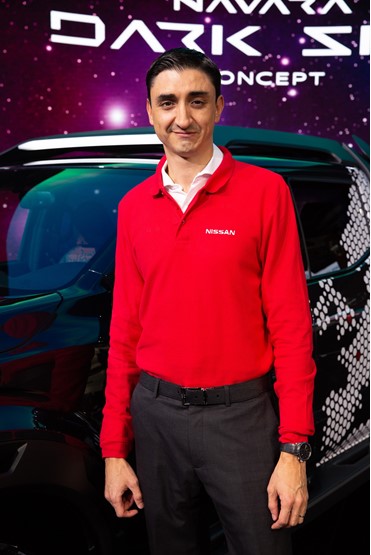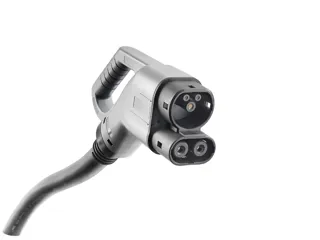Ford used this year’s IAA Hannover Commercial Vehicle Show to announce that it will be making two new connected vehicle packages available to British and German fleet operators next spring through its Ford Commercial Solutions (FCS) unit. Other markets will follow in subsequent months.
“Today’s fleets are under huge pressure to deliver safe, efficient and legal operations,” says FCS Europe director Dave Phatak (below).
“Our solutions will allow them to focus on what matters most to them and that’s running their businesses.”
Ford Telematics is one of the packages that will be offered and will allow operators to view data from connected Ford vehicles through a web-based portal.
Phatak and his colleagues recognise, however, that some major operators may want to work with their own in-house or third-party system providers to develop bespoke answers to the challenges they face.
In response, FCS has come up with Ford Data Services, which gives fleets, telematics service providers and fleet management companies direct access to OE-grade vehicle data.
The presence of a built-in onboard modem allows data to go directly from the vehicle to the cloud without the need for any extra hardware. From there it can be relayed to the fleet’s internal IT system or to a third-party provider.
“It’s a solution that’s engineered for mixed fleets,” says FCS chief executive officer Lee Jelenic (below).

Even operators who primarily favour Fords may have a few Volkswagens or Mercedes on their books.
All sorts of data can be extracted covering everything from the level of fluid in a van’s AdBlue reservoir – it may need topping up immediately – to whether or not the diesel particulate filter has regenerated recently.
“Drivers don’t always tell fleet managers when warning lights illuminate on the dashboard,” Phatak remarks.
Other areas that can be addressed include whether or not a van is being allowed to idle excessively, wasting fuel and emitting pollutants. “That’s a big issue for many managers,” he says.
FCS works with a number of tele-matics services providers in North America, including Verizon Connect, and is now in advanced talks with European providers.
Remote monitoring of battery charge levels and how long it will be before a recharge is required is especially important for anybody running a fleet of electric vans.
Nissan can deliver this type of connectivity to businesses operating its battery-powered e-NV200 through its NissanConnect app, and it is likely to apply to other future battery models in the manufacturer’s line-up.
“Our ambition is to introduce an electric version of each of our vans,” says Paolo D’Ettore (below), director of Nissan Europe’s light commercial business unit.

Revamped earlier this year with a range between recharges extended to 124 miles, according to the WLTP combined cycle, the 40kWh e-NV200 is already proving to be a success story as operators look for vehicles they can deploy on zero-emission last-mile delivery work.
“We received more than 6,000 orders in the six weeks prior to the start of the IAA show,” D’Ettore reports.
An electric NV400 should be easy enough to introduce given that it shares the same basic design as sister brand Renault’s Master, and an electric Master ZE has already been unveiled.
However, D’Ettore was unable to say when a battery-powered NV400 would break cover or when an electric NV300 (which is based on Renault’s Trafic) might put in an appearance.
Nissan has no immediate ambition to introduce driverless vans. “The driver will remain at the centre of what we do,” he observes.
Semi-autonomous technology that can assist drivers and reduce the risk of collisions is a different matter and fleets will increasingly benefit from some of the safety systems it embraces; advanced emergency braking for example. “Nissan has got a vision of zero accidents,” says Pedro Deanda (below), LCV business unit chief product specialist.

What both he and D’Ettore are thinking about is Nissan Intelligent Mobility, a suite of driving assistance technologies which embraces ProPilot.
Installed in the Navara Dark Sky Concept and Navara N-Guard pick-ups, once activated, it automatically controls the distance between the vehicle and the vehicle in front and applies the brakes automatically if there is the risk of a smash.
“It brings you to a complete stop,” says Deanda. “It ensures you remain in lane too.”
Like D’Ettore, he stresses the aim is not to eliminate the driver. “With ProPilot, drivers still have to keep their hands on the steering wheel,” he observes.
In future, this may, of course, change as technology steadily evolves and fully-autonomous vehicles start to appear.
Businesses will still face the challenge of getting packages from the kerbside to the consumer’s front door, especially if the recipient is elderly or disabled.
That may mean that whoever is in the van’s cab will become more of a customer services executive than a driver; or perhaps a concierge, as Renault describes the mobile supervisor responsible for overseeing its concept EZ-PRO string of driverless electric delivery pods.
The role of electric vans in last-mile delivery looks set to become increasingly significant and Volkswagen Commercial Vehicles is responding accordingly, says worldwide executive vice-president, sales and marketing, Heinz-Jurgen Low.
> JURGEN LOW
It has already unveiled a battery-powered Crafter and was exhibiting an electric Caddy and Transporter. The zero-emission Caddy is set to go on sale in mid-2019, says Low.
It is producing both models in conjunction with specialist engineering company ABT. That could result in volume constraints, but Low does not see that as a major issue.
While battery vans may have long-term potential, they are not yet selling in huge numbers, he points out. “Look at the registration figures,” he says.
Having the right charging infrastructure in place is a major consideration if electric vans are to be adopted more widely. If the driver takes his van home and has to park it in the street, then where does he charge it up?
The Cargo e-Bike electric tricycle may be a somewhat unusual product for a mainstream manufacturer to introduce. It was announced at the IAA can be used for last-mile deliveries of small packages in urban areas and will definitely be going on sale, says Low.
“We may decide to sell it via the internet,” he says.
Autonomous driving will come, he believes, initially in the USA, then China, then in Europe, offering a variety of benefits.
“Let’s suppose a plumber comes to your house and can’t find a parking space,” he says. “An autonomous van can go off and find one while he starts work.
“I can certainly envisage autonomous shuttle buses,” he adds. “They don’t really require a driver and nobody wants to do the job, anyway.”
Back in June, VW and Ford said they were contemplating a strategic alliance that could involve the future joint development of light commercials. The replacement for the Amarok pick-up, launched eight years ago, is being touted as one potential joint-venture project by industry insiders.
“It’s too early to predict the results of these talks,” insists Low. “Nothing is included, but nothing is excluded.”

















Login to comment
Comments
No comments have been made yet.